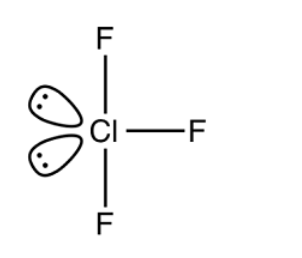
What is the hybridization of chlorine atom in
Answer
506.7k+ views
Hint: Count the number of lone pairs and bond pairs of electrons present on the central chlorine atom.
Complete step by step answer:
Chlorine trifluoride contains a central chlorine atom which forms bonds with three fluorine atoms. Chlorine atom has 7 valence electrons with the valence shell electron configuration of
The electron pair geometry for three bond pairs of electrons and two lone pairs of electrons is trigonal bipyramidal. The molecular geometry is T-shaped with a bond angle of

Note:
Do not ignore the lone pairs of electrons while determining the type of hybridisation.
If you consider only 3 bond pairs of electrons, then
Complete step by step answer:
Chlorine trifluoride contains a central chlorine atom which forms bonds with three fluorine atoms. Chlorine atom has 7 valence electrons with the valence shell electron configuration of
The electron pair geometry for three bond pairs of electrons and two lone pairs of electrons is trigonal bipyramidal. The molecular geometry is T-shaped with a bond angle of

Note:
Do not ignore the lone pairs of electrons while determining the type of hybridisation.
If you consider only 3 bond pairs of electrons, then
Recently Updated Pages
Master Class 12 Business Studies: Engaging Questions & Answers for Success

Master Class 12 English: Engaging Questions & Answers for Success

Master Class 12 Social Science: Engaging Questions & Answers for Success

Master Class 12 Chemistry: Engaging Questions & Answers for Success

Class 12 Question and Answer - Your Ultimate Solutions Guide

Master Class 11 Economics: Engaging Questions & Answers for Success

Trending doubts
Draw a labelled sketch of the human eye class 12 physics CBSE

a Tabulate the differences in the characteristics of class 12 chemistry CBSE

Which one of the following is a true fish A Jellyfish class 12 biology CBSE

Why is the cell called the structural and functional class 12 biology CBSE

Differentiate between homogeneous and heterogeneous class 12 chemistry CBSE

Write the difference between solid liquid and gas class 12 chemistry CBSE




